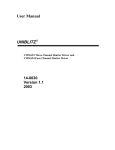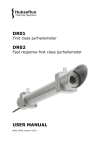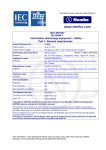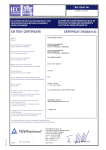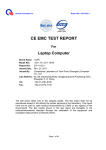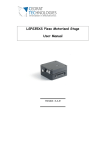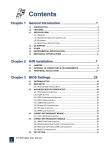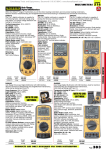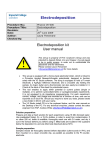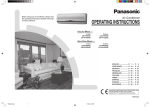Download operating manual - Pennybuying Offical Blog | The Offical Blog Of
Transcript
OPERATING MANUAL MHS2300 Series Dual-channel DDS Signal Generator December 2013 Zhengzhou Ming He Electronic Technology Co., Ltd. Contents 1.Contact..........................................................................................................1 2.Inspecting Package Contens.........................................................................1 3. Summary......................................................................................................2 3.1 Brief Introduction..................................................................................2 3.2 The Instrument model ..........................................................................2 3.3 Features...............................................................................................2 3.4 Technical Data......................................................................................3 4. Instrument Introduction.................................................................................7 4.1 Panel Introduction ................................................................................7 4.2 Function Introduction............................................................................7 4.3 Display Introduction..............................................................................8 5. Operation ...................................................................................................10 5.1 Power on............................................................................................10 5.2 Operating Instruction............................................. 错误!未定义书签。 6.Caution......................................................................... 错误!未定义书签。5 7.Warranty......................................................................................................16 1. Contact Mr. LIAO YAOFENG, Cell:008613570580543,Tel: +862034553996, 1/F, NO.2-2, SANZHUANG RD., HE CUN, DASHI TOWN,PANYU DISTRICT , GUANGZHOU CITY, CHINA ZIP:511430 Tel: +862034553996, Cell:008613570580543 2. Inspecting Package Contents When you get a new DDS signal generator of MHS2300, please inspect the instrument as follows: 2.1 Check if there is damage due to transportation If the package is damaged, please retain them until the instrument and accessories are tested. 2.2 Check package contents Contents of the case are as bellows, if the content does not match with the packing list or the instrument is damaged, please contact us. DDS signal generator 1pc Accessories: DC 5V adapter 1pc USB cable 1pc Signal output cable 2pc User manual 1pc CD 1pc 2.3 Check the machine If the machine was damaged; did not work properly or failed to pass performance tests, please contact your dealer or our company. 1 3. Summary 3.1 Brief introduction Large –scale CMOS integrated circuits, high-speed 32-bit ARM microprocessor and surface mount technology were adopted, which improved the instrument’s immunity and longevity greatly. 2.4 inch TFT LCD screen with 320*240 resolutions was able to display all the parameters of the two channels and prompt the current key functions, avoid pressing buttons repeatedly. The instrument has applications in electronic engineering labs, production facilities, service shops, and schools. 3.2 The Instrument Model l MHS2300A-05M Sine frequency up to 5MHz, amplitude up to 20Vp-p l MHS2300A-10M Sine frequency up to 10MHz, amplitude up to 20Vp-p l MHS2300A-20M Sine frequency up to 20MHz, amplitude up to 20Vp-p as frequency ≦15MHz; amplitude up to 15Vp-p as frequency >15MHz. 3.3 Features 3.3.1 Adopting direct digital synthesis (DDS) technology, FPGA design, and ultra-low power consumption; 3.3.2 With portable aluminum alloyed shell, sole DC 5V powered adapter, easy to carry; 3.3.3 With a 2.4-inch TFT color LCD, variable function soft keys and a rotary encoder, greatly enhances the usability of the instrument; 3.3.4 Perfectly symmetrical two channels can be synchronized to work, and the phase adjustable; 3.3.5 Two or multi-machines can be achieved multi-machines synchronous by TTL_IO port; 3.3.6 Various basic function waveforms of sine, triangle, square, saw tooth, and pulse (duty adjustable); 3.3.7 The minimum output signal frequency to 10µHz; 3.3.8 With 100 sets (M00~M99) parameter storage locations, data of M00 can be loaded as power on; 3.3.9 With 15 sets arbitrary waveform storage locations for users self-defining, memory depth of each set is 1024*10 bits; 3.3.10 Amplitude up to 20Vp-p as frequency ≦15MHz; amplitude up to 15Vp-p as frequency >15MHz; 3.3.11 Minimum frequency resolution reaches 10µHz, minimum amplitude resolution to 10mV; 3.3.12 With DC offset function (-100%~+100%); 2 3.3.13 With FSK function, hop frequency, carrier frequency and FSK rate can be set freely; 3.3.14 Three trigger modes, manual trigger, internal CH2 trigger, external trigger, an arbitrary burst of 1~1048575 can be outputted; 3.3.15 If the setting is +100%, any CMOS digital signal of 0~10V can be outputted; 3.3.16 Duty adjustment of pulse wave is accurate to 0.1%. 3.3.17 The burst function can control the output pulses from 1 to 1048575. 3.3.18 Frequency sweep, amplitude sweep and duty sweep with an arbitrary start and end point. 3.3.19 With functions of frequency measurement, period measurement, positive and negative pulse width measurement, duty cycle measurement and counting. 3.3.20 All parameters can be calibrated by internal program. 3.3.21 Powerful communication functions and the completely open communication protocol, which makes it very simple to the secondary development. 3.3.22 After in connection with the PC, the PC can be used to control the instrument and arbitrary waveforms edited on the PC can be download to the instrument to output. 3.4 Technical data Technical data MHS2300A-05M/10M/20M Normal: MHS2300A-05M:0Hz~5MHz; MHS2300A-10M:0Hz~10MHz; Main output Frequency range Sine MHS2300A-20M:0Hz~20MHz。 Ultra-low frequency :0~600Hz Square 0Hz~5MHz Triangle 0Hz~5MHz Saw tooth 0Hz~5MHz 3 Output Arbitrary 0Hz~5MHz CMOS 0Hz~5MHz modulation Frequency sweep、 amplitude sweep、duty cycle sweep、 FSK、burst Waveform Sine、Square、triangle、pulse、ramp、CMOS、Arbitrary Waveform length 1024 points Sampling rate 200MSa/s Wave accuracy 10bits Frequency resolution 10mHz(Normal),10μHz( Ultra-low frequency ) Frequency error ±5×10-6 Frequency stability ±1×10-6 MHS2300A-05M : 10mVp-p~20Vp-p; Amplitude range (peak to peak) MHS2300A-10M : 10mVp-p~20Vp-p; MHS2300A-20M : 10mVp-p~20Vp-p(frequency≦15MHz), 10mVp-p~15Vp-p(frequency>15MHz) Output impedance 50Ω±10% Amplitude resolution 10mVp-p Amplitude stability ±0.5%(per 5 hours) Amplitude error Offset range Offset resolution ± 1%+10mV(frequency 1KHz., 20Vp-p) -100%~+100%(the ratio of offset voltage to signal amplitude) 1% 4 Phase range Phase resolution Sine Square TTL/CMOS Harmonic distortion 0~360° 1° 40dBc(<1MHz) ,35dBc(1MHz~20MHz) Distortion factor <0.8%(20Hz~20KHz) Rise or fall time ≤20ns Overshoot ≤10% Duty adjustment range 0.1%~99.9% Rise or fall time ≤20ns Low level <0.3V High level 1V~10V Duty>50% Rising saw tooth Duty<50% Falling saw tooth Saw tooth Quantity Arbitrary Memory depth / set Sweep mode Sweep Measurement Sweep time 15 sets 1024*10bits Frequency sweep, amplitude sweep, duty sweep 1S~99S Sweep range Depending on the settings saved in M1 of CH1 and CH2 Frequency measurement range 1Hz~60MHz(Normal),0.01Hz~1kHz( Ultra-low frequency ) Min. input voltage 0.5Vp-p Max. input voltage 20Vp-p 5 Counting range 0~4294967295 Counting mode Manual Positive and negative pulse width measurement 10ns resolution,Max. up to10s Period measurement 20ns resolution,Max. up to20s Duty measurement 0.1% Signal option 1.Ext.IN input(Analog signal ),2.TTL_IN input(Digital signal) resolution,0.1%~99.9% Quantity 100 Location M00 to M99 range Save Interface Interface mode USB to Serial Interface Communication speed 9600bps,19200bps,57600bps or 115200bps optional Communication address 01~99 Verifying mode LRC verifying or not verifying Communication protocol Open Power supply DC 5V adapter Dimensions 146×96×56mm (W*H*D) Weight 416g 3-1 MHS2300A series technical data 6 4. Instrument Introduction 4.1 Panel Introduction Item Introduction Item Introduction 1 Color LCD 6 CHI Output terminal 2 Operating buttons 7 CH2 Output terminal 3 Knob 8 DV5V Power supply interface 4 TTL_IO Input/ Output 9 USB Communication interface 5 Ext.In Input terminal 10 Power switch 4-1 MHS2300A series panel Introduction 7 4.2 Function Introduction Item Function Introduction 1 Parameters of CH1 2 Operating function prompts 3 Parameters of CH2 4 Key function prompts 4-2 MHS2300A series Function Introduction 4.3 Display Introduction 8 Item Display 1 CH1/CH2 Introduction The current parameters of CH1 / CH2 The current waveform, Sine Square 2 Triangle 3 / Arbitrary Off/On 4 The current offset is set to 0%, the setting range from -100% to +100% refers to the ratio of offset voltage to amplitude, +100% indicates the waveform in the positive, if the setting waveform is a square wave with an amplitude of 5V, which can be output as a digital signal of 5VTTL, so different amplitudes can generate different CMOS level digital signal wave. 5 The current duty is set to 180º, the phase setting of CH1 refers to the phase difference between two CH1s of the different machines as multiple machines connected, single machine working does not make sense, the phase setting of CH2 indicates the phase difference between CH1 and CH2 of the same machine. 6 The current frequency is set to 10kHz. 7 The current amplitude is set to 10kHz (peak to peak value). 8 The current duty is set to 50.0%, it should be noted that this setting is only valid for triangle and square wave except sine wave, the duty of square wave is set in the range from 0.1% to 99.9%, for the triangle, the setting is in three cases: Duty = 50.0% is the standard triangle wave, Duty> 50.0% is the rising saw tooth, Duty <50.0% is the falling saw tooth. 9 Generally speaking, the content displayed in the middle indicates the key operating tips, or some 9 special setting values. The three keys can control channels of CH1 and CH2, specifically, controls CH1, controls CH2, OK controls two channels simultaneously. 10 The model and current firmware version number of the machine can be displayed as pressing the key of F1. 11 Settings of CH1 12 Refers to an auxiliary function of the machine, such as setting the sound of on or off, frequency measurement, cycle measurement, communication settings etc. 13 Settings of CH2 Two options of save and load appear by 14 pressing , save represents the current specific parameter settings of CH1 and CH2 to be saved in Flash memory to the machine, there are 100 specific storage locations from M00 to M99.Load indicates the content of the Flash memory to be loaded, the machine can load parameter of M00 automatically at boot time, M01 storage location is mainly for some of the parameters set the sweep function. 4-2 MHS2300A series Display Introduction 5. Operation 5.1 Power On 5.1.1 Plug 5V adapter, switch on. 5.1.2 The LCD displays the company name and version number of the instrument. 10 5.1.3 Enter into the main interface. 5.2 Operating Introduction 5.2.1 Set waveforms of CH1. In the main interface, after pressing the button of press you press and , , the waveforms of sine, square and triangle can be switched, if , an arbitrary wave will be outputted. The machine has 15 waveform storage locations of 1024 * 10bits. Rotating the knob or pressing which can load 15 arbitrary waves circularly, pressing which can set the next frequency, you can quickly switch waveform settings of CH2 as pressing . 5.2.2 Set frequency of CH1. In the main interface, press , a cursor appears and then pressing and , which can move the cursor. Rotate the knob to adjust, as shown below. In the mode of frequency setting, press to switch to the ultra low frequency mode. In the mode of ultra low frequency, the frequency resolution is 10uHz, the maximum setting frequency is 600Hz. Press to switch to the normal mode, in this mode, the minimum frequency resolution is 10mHz. Amplitude setting is similar to that of frequency 5.2.3 Set amplitude of CH1. In the main interface, press , a cursor appears and then pressing and , which can move the cursor. Rotate the knob to adjust, as shown below. 10.00V refers to peak to peak value; press 11 to fine adjustment, the minimum step value is 0.01V, press to the quick adjustment, the minimum step value is 0.04V. 5.2.4 Set offset duty and phase of CH1. In the main interface, press settings, then , and there is no offset, duty and phase appears corresponding to the button of F5, which means that there are other settings below, after pressing next page, then F1 becomes and enter the , that is paging up, as F5 turns into , which also means that there are settings below. The offset, duty and phase settings are in the middle, which are similar to that of frequency. 5.2.5 Sweep function of CH1 and enter In the main interface, after pressing the sweep operation interface, pressing the machine can achieve frequency sweep, amplitude sweep and duty sweep switching,the time setting range is from1 to 99 seconds, the settings of sweep start and end values are saved in the storage location M01, so if you need to use the sweep function, it is necessary to set the stored value of M01. We define the starting value is the value of CH1 in the storage location M01, the end value is the value of CH2 in the storage location M01, so if we want to achieve sweep from 10kHz to 100kHz, CH1 need to be set to 10kHz, CH2 need to be set to 100kHz, and the current value need to be stored in the M01, then enter the operation interface, which can start sweeping and set the sweep time, pressing 5.2.6 Synchronization function of CH1 In the main interface, press to enter the synchronization settings, it should be noted that the synchronization function of CH1 is available only when multi-machine connections require to maintain a certain value of frequency and phase synchronization, set synchronization, at the same time TTL_IO need to be set as input, and which can connect another terminal of TTL_IO set to output by cable 5.2.7 Pulse burst function of CH1 In the main interface, press to enter the trigger setting, there are three trigger modes: manual trigger, internal CH2 trigger and 12 external trigger. Press , the three trigger modes can be switched. The default trigger mode is the manual trigger mode; internal CH2 trigger mode: a continuous pulse sting can be outputted which affected by CH2, external trigger mode: trigger pulse affected by input signal from an external. All three modes set the desired number of pulses (1 to 1048575) by knobbing , and then press and pressing buttons. Press can be output, as shown in the figure of 5 pulse strings: , pulse strings set 5.2.8 FSK function of CH2 to enter FSK interface, In the main interface, press hop frequency, carrier frequency and FSK rate can be set. Pressing can set hop frequency, the max. hop frequency up to 90KHz. A curse appears as setting, the curse can be moved by pressing and , rotate the knob to adjust, as follows: Pressing can set carrier frequency, the carrier frequency is the can set FSK rate, which is the frequency of CH2, and pressing frequency of CH1, its setting method has been introduced above. 5.2.9 Synchronization function of CH2 Synchronization of CH2 refers to some values of the CH2 is controlled by CH1 and consistent with CH1, it can achieve frequency tracking, amplitude tracking and duty tracking, if frequency tracking is selected, and the phase difference is the phase setting of CH2. 5.2.10 TTL_IO settings TTL_IO settings are configured for the machine TTL_IO port, specifically TTL_IO can be configured as an input and also as an output. Configured as inputs can have two purposes, one is mentioned above for multiple synchronous machine cascade, and another use is as a digital signal input terminal to measure frequency, period, positive width, negative width, duty and other parameters of the external pulse. TTL_IO configured as an output is only used to synchronize multiple machines connected to the source. Specific 13 ,you can enter the relevant settings. operation is pressing 5.2.11 Input Settings Input setting is used to set the input source of external measurement functions, the input source has two options: TTL_IN (TTL_IO need to be set as input) and Ext.IN, the essential difference between the two input sources is that TTL_IN is for digital signal, the signal into the machine without DC-blocking capacitors, so very low frequency signal (even less than 1Hz) can be measured, but Ext.IN is the signal input with conventional DC-blocking capacitors, which is suitable for most measurement applications. Specific settings are also very simple, press you can enter the relevant settings. 5.2.12 Sound Settings The machine comes with a buzzer when pressing buttons and rotating knob, you can produce sound, if you do not want to have voice prompts, you can turn off the sound function, after pressing , you can enter the relevant settings. 5.2.13 Function of frequency measurements to enter the external signal frequency measurement, Press you can measure the signal frequency connected to Ext.IN or TTL_IN (specifications are determined by the input setting of section 9) signals. There are two options for measuring the frequency, HF and LF, respectively high frequency and low frequency, if selected in the HF, the measurement resolution is 1Hz, the highest measurement is up to 60MHz, if selected in the LF, the measurement resolution is 0.01Hz, the highest measurement reaches 1kHz. 5.2.14 Function of period parameter measurement Press , there are four measurement items can be selected, T represents the conventional period measurement, TH indicates a positive pulse width measurement, TL indicates a negative pulse width measurement, these three units are ns, Duty is duty cycle measurements, actually that is the ratio of T and TH. 5.2.15 Counting function Press , you can record the number of external pulse and run operations of stop and clearing, these operations are manual, this counter counts the maximum up to 4294967295. 5.2.16 Communication settings 14 The machine with a USB interface can be communicated with a PC computer, communication hardware is based on USB to serial port. Press , you can see the settings of baud, address and verifying, baud is the baud rate, there are four ranges (9600, 19200, 57600and 115200) can be set, addresses can be set in the range of 01 to 99.This machine can be used for multi-connection control, Verifying setting is setting LRC verifying mode, the default is not to verify, w hen you need high reliability, and can run this function 5.2.17 Calibration function All products have passed calibration before go out, pressing can enter it, which can calibrate the machine to very high accuracy, but also calibrate the amplitude of CH1 and CH2, specifications are not described, you can consult the factory if calibration is required. 5.2.18 Language setting The machine supports both Chinese and English interface, users can switch as needed, the specific method is . pressing 5.2.19 Save / load function There are 100 storage locations inside the machine for saving user's settings, in the main interface, after pressing , you can see “Memory 00” displayed and rotate the knob, which storage location for storage can be set, and then press or to complete your desired operating. 6. Cautions 6.1 Make sure the input power adapter correctly, the machine uses DC5V power adapter; 6.2 The LCD of the instrument is fragile, perishable, please do not clash violently and close to chemicals to avoid corrosion. As the LCD surface is dusty and dirty, please wipe with a soft cloth carefully 6.3 Operating temperature is from -10 to 50 degrees Celsius, and storage temperature is from -20 to 70 degrees Celsius; make sure the instrument kept dry 6.4 Do not attempt to disassemble the instrument, destroying the package will void the warranty, this instrument has no user-serviceable parts inside, if it need to be repaired, you can repair it by specifying outlets, or return to the factory for repair 6.5 Do not place lighted candles, cups filled with water, corrosive chemicals and other unsafe items on the instrument to avoid damage to the instrument 15 6.6 The display screen is an easily contaminated, fragile device, do not touch and crash, and avoid children playing the instrument 6.7 Do not move the instrument violently as it is working to avoid irreparable damage to the internal circuitry 6.8 When you start the sound options, the normal ringing sound of the keys will be accompanied, if this does not occur, in other words, the key may be damaged or the internal circuit is damaged, please contact the supplier. In addition to the above problems, the instrument still does not work properly, please contact the supplier! 7. Warranty and service Maintenance and Warranty This instrument is a high-precision electronic device, in order to give full play to its function, please read the following about maintenance, safety and effective use of guidance before using. Thank you for purchasing our products. To maximize the use of the new product features, we recommend that you take the following steps: 1 Read safe and efficient use instruction. 2 Read the warranty terms and conditions. We warrants to the original purchaser that its product and the component parts thereof will be free from defects in workmanship and materials for a period of one year from the data of purchase. We will repair or replace, at its’ option, defective product or component parts. Returned product must be accompanied by proof of the purchase date. Exclusions: This warranty does not apply in the event of misuse or abuse of product or as a result of unauthorized alternations or reapers. It is void if the serial number is alternated, defaced or removed. 16




















